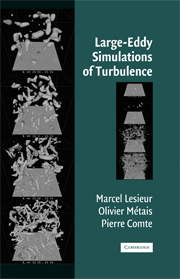8 - Geophysical fluid dynamics
Published online by Cambridge University Press: 06 July 2010
Summary
As already stressed, the large-eddy simulation (LES) concept was developed by the meteorologists Smagorinsky, Lilly, and Deardorff. In fact, geophysical and astrophysical fluid dynamics contain an innumerable list of processes (generally three-dimensional) that can be understood experimentally only via laboratory and in situ experiments and numerically mostly by LES. We recall, for instance, that the Taylor-microscale-based Reynolds number for smallscale atmospheric turbulence is larger than 104, and thus implementation of DNS does not seem feasible in this case even with the unprecedented development of computers. As far as Earth is concerned, these processes are part of the extraordinarily important issue of climate modeling and prediction involving a very complex system that dynamically and thermodynamically couples the atmosphere (with water vapor, clouds, and hail), the oceans (with salt and plankton), and ice for periods of time from seconds to hundreds of thousands of years. The issue of global warming, which requires our being able to predict the evolution, under the action of greenhouse-effect gases, of Earth temperature (in the average or in certain particular zones), is vital for the survival of populations living close to the oceans and seas. Indeed, global warming induces ice melt, which implies a sea-level elevation. It also increases evaporation, resulting in heavy rains and floods.
We first provide in this chapter a general introduction to geophysical fluid dynamics (GFD). Then we will concentrate on two problems for which LES and DNS provide significant information. The first is the effect of a fixed solid-body rotation on a constant-density free-shear or wall-bounded flow. The second is the generation of storms through baroclinic instability in a dry atmosphere.
- Type
- Chapter
- Information
- Large-Eddy Simulations of Turbulence , pp. 185 - 204Publisher: Cambridge University PressPrint publication year: 2005



